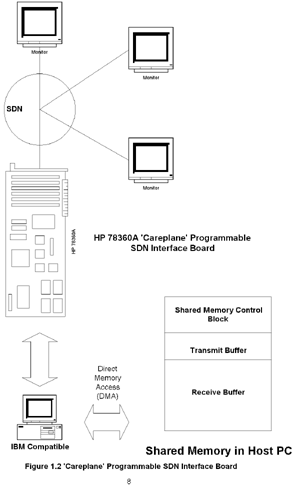Serial Distribution Network | HP 78360A 'Careplane' Programmable Interface Board | Bedside Monitors
The Hewlett-Packard Serial Distribution Network (SDN) is a local area digital communications network designed to share physiological variables among patient bedside monitors in a clinical environment. It allows real-time transfer of digitised data between monitors. A proprietary interface card that may be installed in a desktop PC allows access to the data for both recording and processing. The SDN uses a star topology (figure 1.1) that has up to 32 individual branches emanating from the centre of the star, the System Communications Controller (SCC). The SCC is the active node, and controls data flow, timing, synchronisation and distribution throughout the network. Branches are connected to the SCC using shielded twisted pair wiring, with half-duplex differential transmission of the digital data. Only one instrument transmits data at a time, and the SCC broadcasts the data from that branch to all other branches on the system. The SCC acts as a rotary switch, allowing each branch to transmit all its available data within predetermined cycles. A complete system cycle is 1,024 milliseconds. This is divided into 32 cycles of 32 milliseconds each, known as poll cycles. At the beginning of a poll cycle, the SCC receiver for a single branch is enabled, allowing the instrument on that branch to talk. The SCC then buffers, re-times and broadcasts the data to the other 31 branches. When it senses the end of the transmission, it turns off this branch receiver and sequences to the next branch. An SDN has been in operation in the Royal Infirmary, Edinburgh since 1994. The Intensive Therapy Unit has ten branches, the Scottish Transplantation Unit has four, and there is a single branch to an operating theatre. In addition, there is a branch to a desktop PC in an office.
A programmable interface board is available from HP that enables communication between the SDN and an IBM-compatible PC. The board uses Direct Memory Access (DMA) to transfer data from the SDN via the ISA bus to an area of shared memory in the PC (figure 1.2). The board must be configured to use a specific DMA channel and I/O port. It is supplied with a basic program for testing, but it is up to the programmer to develop applications for acquisition and display/logging of data. Throughout this text, the board is referred to as 'Careplane'. HP specifies that the interface board must be installed in an IBM-compatible PC. There is no provision for installation in a workstation.
Each branch on the network is connected to an identical HP bedside monitor for the acquisition, display and broadcasting of physiological variables. There are a number of 'channels' available accessed by plug-in modules. Modules are specific for particular variables. For example, there are separate modules that handle ECG, SaO2, pressure or temperature data. HP has developed plug-in modules for equipment made by other manufacturers, in particular, a module to collect data from a Baxter Vigilance (TM) continuous cardiac output computer. Several clinical research projects have benefited from this link with the SDN that broadens the range of physiological data available. It is promising to see medical equipment manufacturers co-operating to reduce the burden of software development.

